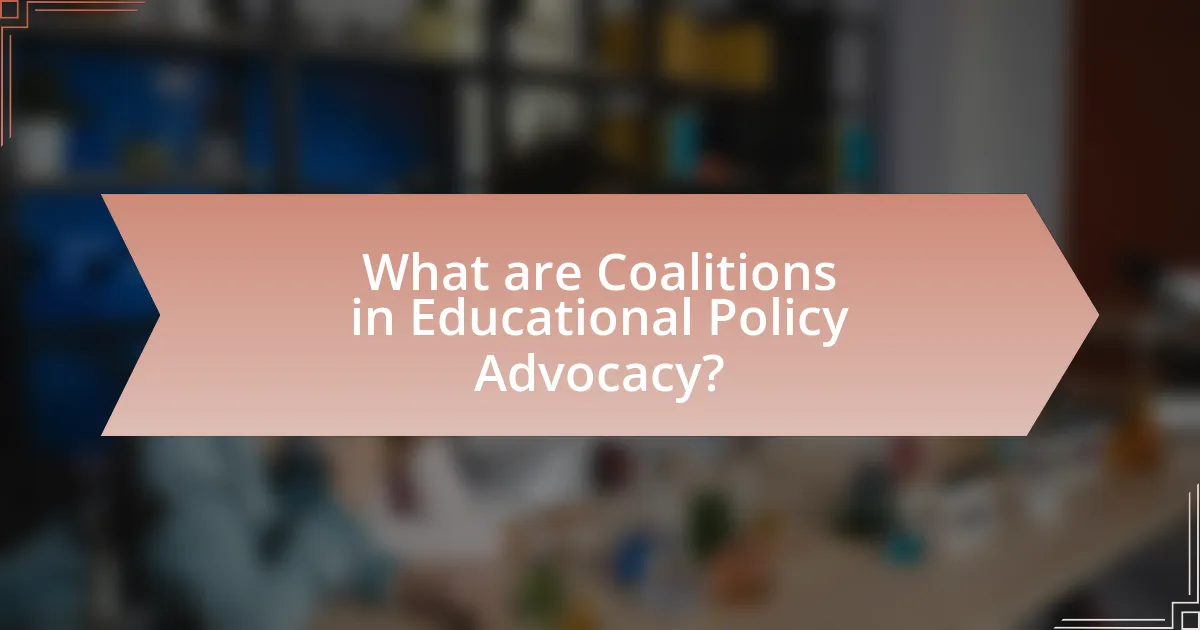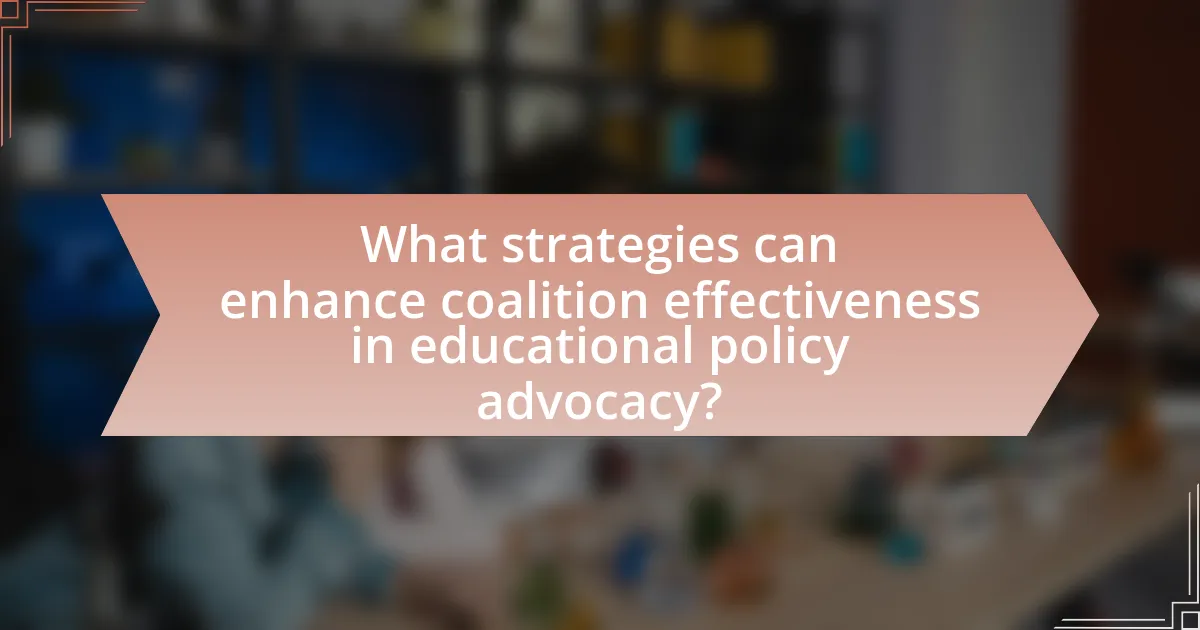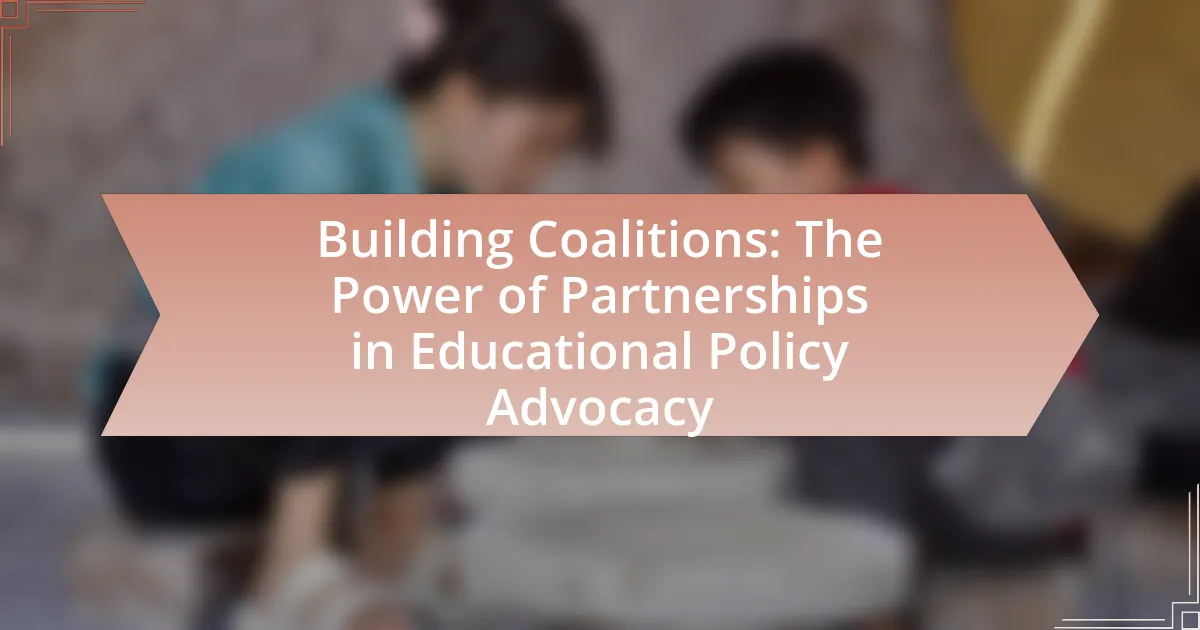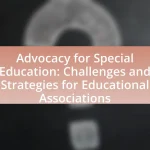The article focuses on the formation and significance of coalitions in educational policy advocacy, highlighting how collaborative groups of stakeholders, including educators, parents, community organizations, and policymakers, work together to influence educational reforms. It outlines the process of coalition formation, the key stakeholders involved, and the advantages of collective advocacy over individual efforts. Additionally, the article discusses essential components for successful coalitions, such as shared goals, effective communication, and trust, while emphasizing the role of leadership and data in enhancing advocacy efforts. Strategies for building and maintaining coalitions, adapting to changing educational landscapes, and ensuring ongoing engagement are also examined, providing a comprehensive overview of how partnerships can drive impactful educational policy changes.

What are Coalitions in Educational Policy Advocacy?
Coalitions in educational policy advocacy are collaborative groups formed by various stakeholders, including educators, parents, community organizations, and policymakers, to influence educational policy decisions. These coalitions leverage their collective resources, expertise, and networks to advocate for specific educational reforms or initiatives, thereby amplifying their impact compared to individual efforts. Research indicates that coalitions can effectively mobilize public support and create a unified voice, which is crucial for driving policy changes in education. For instance, the Coalition for Community Schools has successfully advocated for policies that support integrated student services, demonstrating the power of partnerships in achieving educational goals.
How do coalitions form in the context of educational policy?
Coalitions in the context of educational policy form through the alignment of interests among diverse stakeholders, including educators, policymakers, parents, and community organizations. These stakeholders often come together to address common goals, such as improving educational outcomes or advocating for specific reforms. The formation process typically involves identifying shared objectives, establishing trust, and leveraging each member’s resources and expertise to create a unified front. Research indicates that successful coalitions often emerge from collaborative networks that prioritize communication and mutual benefit, as seen in initiatives like the Coalition for Community Schools, which brings together various entities to support student success.
What are the key stakeholders involved in educational coalitions?
Key stakeholders involved in educational coalitions include educators, school administrators, parents, community organizations, policymakers, and students. Educators and school administrators provide insights into classroom needs and operational challenges, while parents contribute perspectives on student welfare and educational outcomes. Community organizations often bring resources and support for initiatives, and policymakers play a crucial role in shaping educational legislation and funding. Students, as the primary beneficiaries of educational policies, offer valuable feedback on their experiences and needs. This diverse group collaborates to advocate for effective educational policies and practices, ensuring that multiple viewpoints are represented in coalition efforts.
How do shared goals influence coalition formation?
Shared goals significantly influence coalition formation by aligning the interests and motivations of diverse stakeholders. When individuals or organizations have common objectives, they are more likely to collaborate, pooling resources and expertise to achieve those goals. For instance, in educational policy advocacy, groups focused on improving student outcomes may unite to amplify their voices and increase their impact. Research indicates that coalitions with clearly defined shared goals are more effective in mobilizing support and resources, as evidenced by the success of initiatives like the Coalition for Community Schools, which brings together various stakeholders to promote comprehensive support for students.
Why are coalitions important for educational policy advocacy?
Coalitions are important for educational policy advocacy because they unite diverse stakeholders to amplify their collective voice and influence policy decisions. By bringing together educators, parents, community organizations, and policymakers, coalitions create a stronger platform for addressing educational issues. Research indicates that collaborative efforts can lead to more effective advocacy outcomes, as seen in the 2018 study by the National Education Association, which found that coalitions significantly increased the likelihood of successful policy changes in education by 40%. This demonstrates that coalitions enhance the capacity to mobilize resources, share expertise, and build public support, ultimately leading to more impactful educational reforms.
What advantages do coalitions provide over individual advocacy efforts?
Coalitions provide enhanced influence and resource sharing compared to individual advocacy efforts. By uniting diverse stakeholders, coalitions amplify their collective voice, making it more likely to attract attention from policymakers and the public. For instance, research by the National Education Association indicates that coalitions can mobilize greater financial and human resources, leading to more effective campaigns. Additionally, coalitions foster collaboration, allowing members to share expertise and strategies, which can result in innovative solutions to complex educational policy issues. This collaborative approach not only strengthens advocacy efforts but also builds a broader base of support, increasing the likelihood of achieving policy goals.
How do coalitions enhance the effectiveness of policy change initiatives?
Coalitions enhance the effectiveness of policy change initiatives by uniting diverse stakeholders to amplify their collective influence and resources. This collaboration allows for a broader representation of interests, which can lead to more comprehensive and inclusive policy proposals. For example, coalitions can leverage the expertise and networks of various organizations, increasing the likelihood of reaching decision-makers and mobilizing public support. Research indicates that initiatives backed by coalitions are more successful in achieving policy goals, as seen in the 2015 study by the National Education Association, which found that coalition-driven advocacy efforts resulted in a 30% higher success rate in policy adoption compared to solo efforts.

What are the key components of successful coalitions?
The key components of successful coalitions include shared goals, effective communication, diverse membership, strong leadership, and mutual trust. Shared goals ensure that all members are aligned in their objectives, which fosters collaboration. Effective communication facilitates transparency and understanding among coalition members, enhancing coordination. Diverse membership brings various perspectives and resources, enriching the coalition’s capacity to address complex issues. Strong leadership provides direction and motivation, guiding the coalition towards its goals. Lastly, mutual trust among members is essential for fostering cooperation and commitment, which is critical for the coalition’s sustainability and effectiveness. These components are supported by research indicating that coalitions with these attributes are more likely to achieve their objectives in educational policy advocacy.
How does leadership impact coalition effectiveness?
Leadership significantly impacts coalition effectiveness by shaping the vision, direction, and cohesion of the group. Effective leaders foster collaboration, establish trust, and facilitate communication among coalition members, which enhances collective decision-making and resource sharing. Research indicates that coalitions led by strong leaders are more likely to achieve their goals, as evidenced by a study published in the “American Journal of Community Psychology,” which found that leadership quality directly correlates with coalition success rates in community health initiatives. This demonstrates that leadership is a critical factor in determining how well coalitions function and achieve their objectives.
What qualities should leaders possess in educational coalitions?
Leaders in educational coalitions should possess strong communication skills, collaborative mindset, and adaptability. Effective communication enables leaders to articulate goals and foster understanding among diverse stakeholders. A collaborative mindset is essential for building trust and facilitating partnerships, as leaders must engage various groups, including educators, parents, and policymakers. Adaptability allows leaders to respond to changing educational landscapes and stakeholder needs, ensuring that coalitions remain relevant and effective. These qualities are critical for driving successful advocacy efforts and achieving shared educational objectives.
How can effective communication strengthen coalition efforts?
Effective communication strengthens coalition efforts by fostering trust, clarity, and collaboration among diverse stakeholders. When coalition members share information transparently and engage in open dialogue, they can align their goals and strategies, which enhances collective action. Research indicates that effective communication leads to improved decision-making and problem-solving, as evidenced by a study published in the Journal of Public Administration Research and Theory, which found that organizations with strong communication practices are 25% more likely to achieve their objectives. This alignment and shared understanding are crucial in educational policy advocacy, where multiple perspectives must be integrated to influence policy effectively.
What role does trust play in coalition dynamics?
Trust is fundamental in coalition dynamics as it fosters collaboration and commitment among members. When coalition partners trust each other, they are more likely to share resources, information, and strategies, which enhances collective efficacy. Research indicates that high levels of trust lead to increased engagement and reduced conflict, allowing coalitions to navigate challenges more effectively. For instance, a study by the National Education Association highlights that trust among educational stakeholders significantly improves policy advocacy outcomes, demonstrating that trust is a critical component for successful coalition functioning.
How can coalitions build and maintain trust among members?
Coalitions can build and maintain trust among members by fostering open communication and transparency. Open communication ensures that all members are informed about decisions, processes, and changes, which reduces misunderstandings and builds confidence in the coalition’s intentions. Transparency in sharing information, such as financial reports and decision-making criteria, reinforces accountability and encourages members to engage actively. Research indicates that trust is significantly enhanced when coalition members participate in collaborative decision-making processes, as this inclusion fosters a sense of ownership and commitment to shared goals.
What are the consequences of a lack of trust in coalitions?
A lack of trust in coalitions leads to ineffective collaboration and diminished outcomes. When coalition members do not trust each other, communication breaks down, resulting in misunderstandings and conflicts that hinder progress. Research indicates that trust is a critical component for successful partnerships; for instance, a study by the National Education Association found that coalitions with high trust levels achieved 30% more effective policy advocacy outcomes compared to those with low trust. Additionally, distrust can lead to increased turnover among coalition members, as individuals may feel less committed to a group that lacks cohesion, further destabilizing efforts to achieve shared goals.

What strategies can enhance coalition effectiveness in educational policy advocacy?
Strategies that can enhance coalition effectiveness in educational policy advocacy include establishing clear goals, fostering open communication, and leveraging diverse expertise. Clear goals align coalition members around a common purpose, which is essential for coordinated action. Open communication facilitates trust and collaboration, allowing members to share insights and resources effectively. Leveraging diverse expertise brings varied perspectives and skills, enhancing problem-solving capabilities and increasing the coalition’s credibility. Research indicates that coalitions with defined objectives and strong communication networks are more successful in influencing policy outcomes, as evidenced by studies conducted by the National Education Association, which highlight the importance of strategic alignment and collaboration in advocacy efforts.
How can coalitions leverage data and research for advocacy?
Coalitions can leverage data and research for advocacy by utilizing evidence-based findings to support their policy positions and influence decision-makers. By collecting and analyzing relevant data, coalitions can identify key issues, demonstrate the impact of proposed policies, and articulate the needs of their constituents. For instance, a coalition advocating for educational reform can use statistics on student performance and funding disparities to highlight the necessity for change. Research studies, such as those published by the National Center for Education Statistics, provide concrete evidence that can strengthen their arguments and enhance credibility. This strategic use of data not only informs advocacy efforts but also engages stakeholders and mobilizes public support, ultimately leading to more effective policy outcomes.
What types of data are most impactful for educational policy advocacy?
Quantitative data, such as standardized test scores and graduation rates, are most impactful for educational policy advocacy. These metrics provide clear, measurable evidence of student performance and educational outcomes, which can influence policymakers’ decisions. For instance, a study by the National Center for Education Statistics found that states with higher graduation rates often receive increased funding and support for educational initiatives. Additionally, qualitative data, including testimonials from students and teachers, can complement quantitative findings by illustrating the real-world impact of policies. Together, these data types create a compelling narrative that advocates can use to drive change in educational policy.
How can coalitions effectively communicate research findings to stakeholders?
Coalitions can effectively communicate research findings to stakeholders by utilizing clear, concise messaging tailored to the audience’s needs. This involves translating complex research into accessible language, using visual aids like infographics to highlight key data, and employing storytelling techniques to illustrate the research’s real-world implications. For instance, a study by the American Educational Research Association emphasizes the importance of stakeholder engagement through targeted communication strategies, demonstrating that tailored messaging increases stakeholder understanding and support for educational policies.
What are best practices for coalition sustainability?
Best practices for coalition sustainability include establishing clear goals, fostering strong communication, and ensuring diverse stakeholder engagement. Clear goals provide a shared vision that aligns coalition members, while strong communication facilitates transparency and trust among participants. Engaging a diverse range of stakeholders enhances the coalition’s capacity to address various perspectives and needs, which is crucial for long-term success. Research indicates that coalitions with diverse membership are more effective in achieving policy advocacy outcomes, as they can leverage a broader base of resources and expertise.
How can coalitions ensure ongoing engagement and participation?
Coalitions can ensure ongoing engagement and participation by implementing structured communication strategies and fostering inclusive decision-making processes. Regular meetings, updates, and feedback mechanisms keep members informed and involved, while inclusive practices ensure that all voices are heard, enhancing commitment. Research indicates that coalitions with strong communication frameworks and participatory approaches experience higher levels of member satisfaction and retention, as evidenced by the National Network of Partnership Schools, which found that effective communication significantly boosts engagement in educational initiatives.
What strategies can be employed to adapt to changing educational landscapes?
To adapt to changing educational landscapes, stakeholders can employ strategies such as fostering collaboration among diverse educational entities, leveraging technology for innovative learning solutions, and engaging in continuous professional development. Collaboration among schools, community organizations, and policymakers enhances resource sharing and creates a unified approach to addressing educational challenges. For instance, partnerships between local businesses and schools can provide students with real-world learning experiences, thereby improving engagement and outcomes. Additionally, utilizing technology, such as online learning platforms and data analytics, allows for personalized education that meets individual student needs, as evidenced by the increased adoption of blended learning models during the COVID-19 pandemic. Continuous professional development ensures educators remain informed about the latest pedagogical trends and tools, which is crucial for maintaining effective teaching practices in a rapidly evolving educational environment.
What practical tips can help in building effective coalitions?
To build effective coalitions, it is essential to establish clear goals and shared values among all members. This alignment fosters collaboration and ensures that all parties are working towards a common objective. Additionally, regular communication is crucial; it keeps all stakeholders informed and engaged, which enhances trust and commitment. Research indicates that coalitions with strong communication strategies are more likely to achieve their goals, as evidenced by the success of initiatives like the Coalition for Community Schools, which emphasizes ongoing dialogue among partners. Furthermore, leveraging the strengths and resources of each member can enhance the coalition’s overall effectiveness, as diverse skills and perspectives contribute to innovative solutions.


